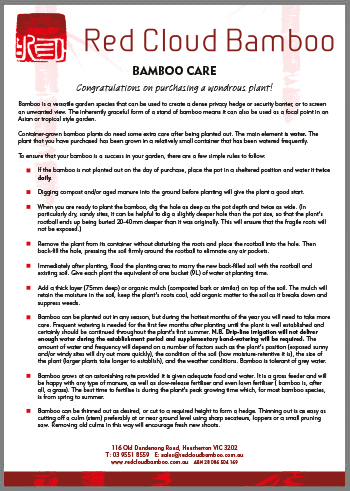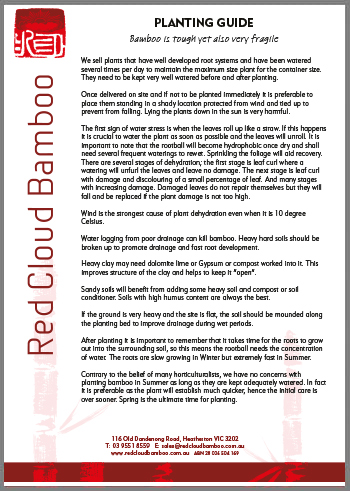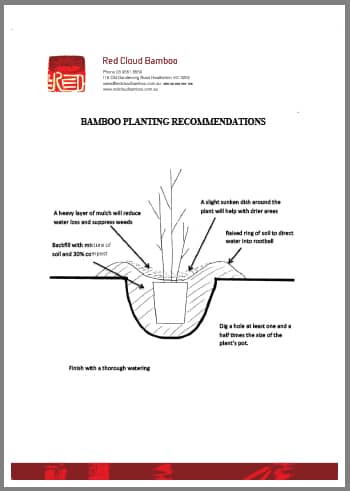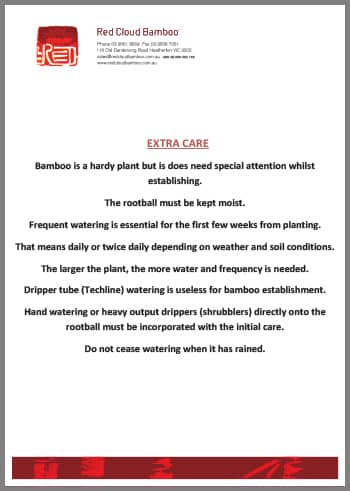CARING FOR YOUR BAMBOO
Thoughts when selecting
Selection of your bamboo plant must be thoroughly thought out. Assessing the site and the purpose of the plant must be carefully considered before planting. Although bamboo plants are very flexible in growth manipulation, a certain amount of work is needed to keep a large growing plant a lesser size. See USES.
General maintenance
Once feeding and watering have been taken care of, to get the best appearance out of your plant, selective pruning should be done. Simply cut out what you don’t like! usually the older culms that are showing their age and any newer culms that you do not want. Actual cutting of the older culms is quite difficult sometimes because of their toughness and accessibility due to tight clumping, so cutting at the preferred ground level is not essential. You will need a sharp saw!
PLANTING GUIDE
Plants in pots that are supplied by Red Cloud Bamboo have been treated with a water retainer but are still susceptible to drying out. Because bamboo is a very fast grower as a young plant it’s water requirements are very high, making it in need of frequent watering. Once you have received your new plants you should keep them in a shady area and keep them moist till you can plant them in the soil or in a larger pot.
Soil Planting
The soil should have good drainage but be able to be kept moist, bamboo does not like to have waterlogged roots. The hole to place the plant in should be at least as deep as the container and twice the width. Incorporate compost, aged manure or any humus rich matter into the planting hole along with high nitrogenous slow release fertilizer. Carefully remove plant from pot being careful with the new fragile shoots as they can snap very easily. Position the plant into the hole at the same level as the soil. Fill In the hole with the soil and incorporated compost and fertilizer and pat down the soil firmly, a little more fertilizer scattered on top would also be beneficial. Create a well around the area to maximize the watering to the root ball. Give the plant a very good watering in and keep moist for the following weeks. A heavy layer of mulch is very beneficial in keeping the moisture in and to insulate the roots from temperature extremes. Stand back and watch it grow.
Container Planting
Planting in containers takes extra care, but can be achieved very successfully. The larger the container the better. Because bamboo has a fine shallow root system, a wider rather than deeper container is best. Use the highest grade potting mix that you can find, it must have high water retention and plenty of slow release fertilizer. If not included in the purchased mix, please add a water retainer product and slow release fertilizer. Place the plant in the container and backfill with the potting mix and pack the soil in quite hard. Filling the top of the pot with a good layer of organic mulch is always favorable but sometimes for aesthetic reasons a layer of pebbles will suffice. Now water small amounts frequently for a day or so to really hydrate the sometimes water repellant potting mix. An automated drip system is an excellent way to keep your plant well watered. A simple cheap system can be easily set up and will save you much anguish because the plant does need frequent watering. Bamboo plants will let you know when they are under water or heat stress by rolling up their leaves, this will almost instantly resolve when watered and or shaded.
Feeding
Bamboo is a heavy feeder, it will survive and grow with little nutrition but to have it growing vigorously and looking in top condition a good feeding regime is necessary. Luckily it is not so fussy on what it is given. Any type of manure is good, although be careful not to place too much fresh manure on any plant as it will burn the roots. Slow release fertilizers are also good as they feed the plant continuously by slowly releasing nutrient. Liquid feed is also very beneficial to boost the nutrient levels quickly, though again be careful of the mix being too strong. The best principal of feeding is to give a little frequently. Bamboo loves nitrogen but take care of too much nitrogen on young plants as it can damage them.




